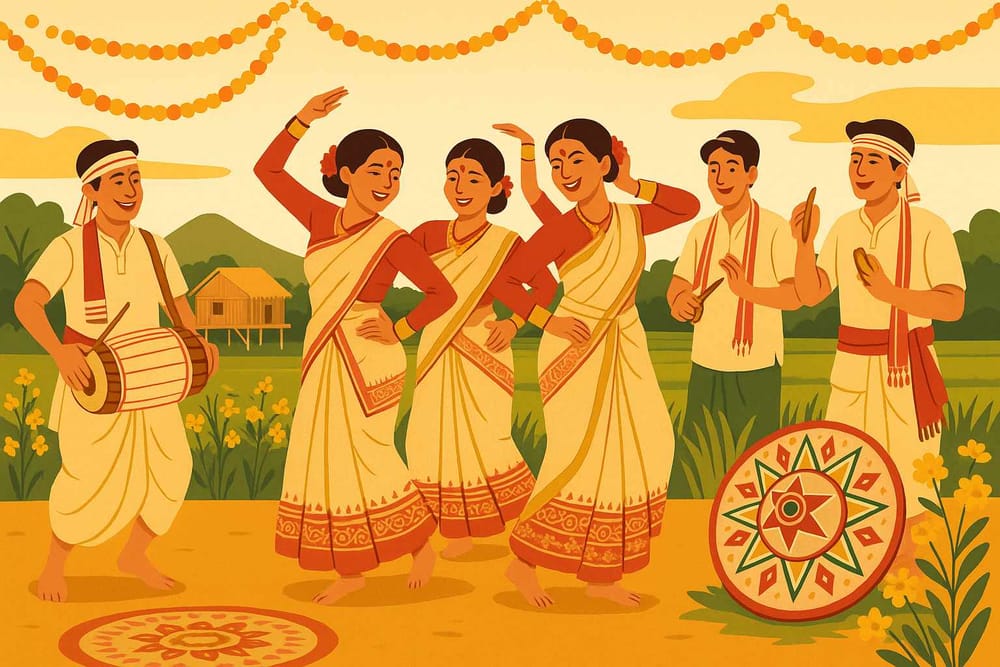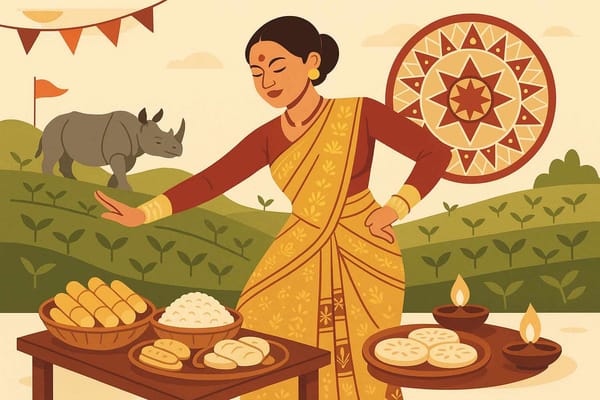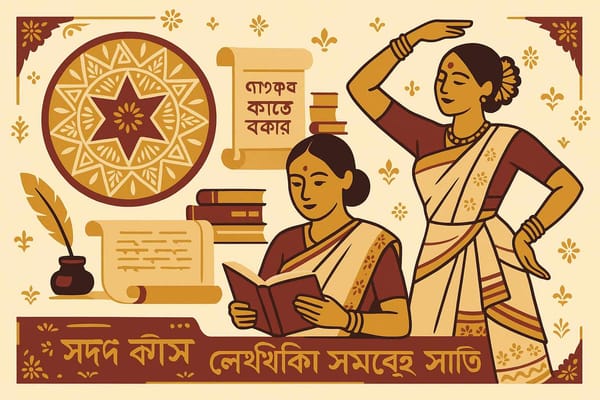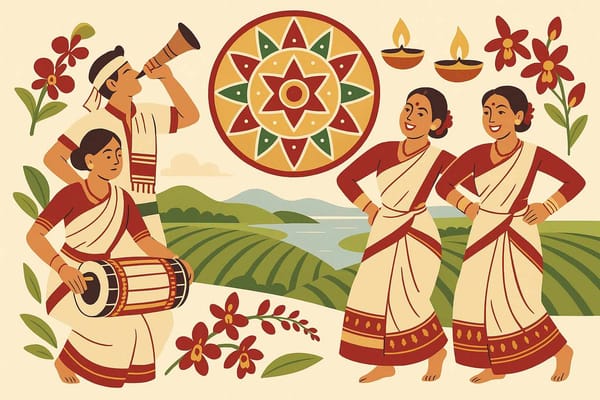
The Essence of Assamese Culture: Traditions and Celebrations Defined
There are some places that you don't just see; you feel them in your soul. Assam is one such place. It’s a land where the mighty Brahmaputra river doesn't just flow, but breathes life into every story, every song, and every festival. When I think of Assamese culture, I don’t just think of facts and figures; I remember the feeling of morning mist over tea gardens, the taste of homemade pitha warming my hands, and the sound of the dhol that makes your feet want to dance. It's a culture that is as rich and fertile as the soil it springs from, a beautiful blend of reverence, artistry, and deep community bonds.
The Rhythm of the Year: Celebrating the Three Bihus
If you truly want to understand the heartbeat of Assam, you must experience Bihu. It isn't a single day's event but a cycle of three beautiful festivals that mark the seasons of a farmer's life, each with its own unique flavour and emotion.
- Bohag Bihu (Rongali Bihu): This is the Bihu of pure, unadulterated joy! Celebrated in April, it marks the Assamese New Year and the arrival of spring. The air fills with the vibrant energy of the Bihu dance, with young men and women in their finest Mekhela Chadors and Dhotis moving to the electrifying beats of the dhol and the sweet melody of the pepa (a buffalo hornpipe). It's a time for new beginnings, for visiting family, and for feasting together.
- Magh Bihu (Bhogali Bihu): Held in January, this is the Bihu of feasts and gratitude. The harvest is in, the granaries are full, and the community gathers to give thanks. The heart of the celebration is the meji, a towering bonfire built from bamboo and thatch, around which everyone gathers to share stories, sing songs, and enjoy delicious Assamese delicacies like til pitha (sesame rice cakes) and narikolor laru (coconut sweets). It's a celebration that warms you from the inside out.
- Kati Bihu (Kongali Bihu): This Bihu, in October, is more sombre and reflective. It’s a time of scarcity ('Kongali' means poor), when the paddy is still growing. Families light earthen lamps (saaki) in their homes, in the granaries, and in the paddy fields, offering silent prayers for a bountiful harvest and protection for their crops. It’s a quiet, beautiful display of hope and faith.
Woven with Pride: The Golden Threads of Assamese Craftsmanship
The artistry of Assam is something to behold, and nowhere is it more evident than in its legendary handloom tradition. The women of Assam are born weavers, turning threads of silk into heirlooms on their looms. The state is famed for its three unique silks.
- Muga Silk: This is Assam's pride, a naturally golden silk found nowhere else in the world. It’s known for its incredible durability and lustrous sheen that actually improves with age. A Muga Mekhela Chador is not just an outfit; it's a legacy passed down from mother to daughter.
- Eri and Pat Silk: Eri silk is lovingly called 'Ahimsa silk' or the fabric of peace, as the silkworms are not harmed in its production. It's incredibly soft and warm. Pat silk, on the other hand, is a brilliant white or off-white silk, perfect for dyeing in vibrant colours and often worn during auspicious occasions.
Beyond the loom, the people of Assam create magic with bamboo and cane, crafting everything from furniture to intricate decorative items. This deep-rooted creativity speaks volumes about how royal traditions shape local celebrations, preserving heritage for generations to come.
Many wonder about the significance of the Assamese Gamosa. This simple white rectangular piece of cloth with its red border is a profound symbol of Assamese identity. It is offered as a sign of respect, used in religious rituals, and serves as a badge of cultural pride for every Assamese person.
Devotion in Motion: The Spiritual Arts of Assam
Spirituality in Assam is not confined to temples; it flows through its music and dance. The most profound example of this is Sattriya, one of India's eight classical dance forms. Born in the 15th-century monasteries or satras under the guidance of the great saint Srimanta Sankardev, Sattriya is a form of worship. Through graceful movements and expressive storytelling, dancers narrate tales from the Ramayana and Mahabharata, creating an atmosphere of pure devotion.
Music is truly an inseparable part of life here. The air often carries the melodies of Borgeet, the classical devotional songs, or the lively rhythm of folk tunes that tell stories of the land, its people, and their beliefs. It’s a beautiful reminder of how the rhythm of heritage, folk music, and dance define culture in its truest sense.
At Bhaktilipi.in, we are deeply moved by these living traditions. We believe that exploring these devotional art forms is a spiritual journey, and we are here to share these timeless stories and philosophies with you, making them accessible for today's world.
A Taste of the Land: Flavours of the Assamese Kitchen
You can learn a lot about a culture from its food, and Assamese cuisine tells a story of simplicity, freshness, and a deep connection to nature. The food is typically low on spice but incredibly rich in flavour, thanks to the use of fresh, indigenous herbs and vegetables.
A quintessential Assamese meal would feature steamed rice with Masor Tenga, a tangy and light fish curry that is both comforting and delicious. Another unique dish is Khaar, prepared with a signature ingredient made from sun-dried banana peels. Then there’s Pitika, a simple yet flavourful mash of roasted or boiled vegetables like potato or eggplant with onion, mustard oil, and chilies. It’s soul food at its finest.
Exploring Assam's Rich Cultural Tapestry
As you delve deeper, you realise that the culture of Assam is not a monolith. It’s a vibrant mix of various indigenous communities, each with its own customs, festivals like the Mishing tribe's Ali Ai Ligang, and dialects. This diversity is what makes the cultural landscape so fascinating.
One might ask what keeps this heritage so vibrant. The answer lies in the people. Assamese culture preserves its heritage through the stories told by grandmothers, the songs sung during festivals, the patterns woven on a loom, and the unwavering faith of its people. Institutions and families work hand-in-hand to ensure these traditions are not just remembered but lived every single day.
In every beat of the Bihu drum and in the serene flow of the Brahmaputra, Assam’s timeless spirit endures. It’s a culture that welcomes you with open arms and leaves an indelible mark on your heart, urging you to celebrate life, community, and the beauty of tradition.
About Bhaktilipi
© 2025 Bhaktilipi – Crafted with devotion.
Bhaktilipi is your digital sanctuary for exploring and preserving timeless devotional literature and stories. We are dedicated to bringing you authentic bhakti content that resonates with tradition while being accessible and inspiring for today's generation.
Discover the spiritual heart of India's diverse cultures, from the vibrant celebrations of Assam to the profound philosophies of ancient texts. Find authentic ritual items, insightful articles, and stories that nourish the soul on our platform.
Stay connected with our community for daily inspiration:
Let Bhaktilipi be a companion on your spiritual journey.
A passionate group of people dedicated to preserving India's knowledge of Dharma, Karma, and Bhakti for ourselves and the world 🙏.
Comments
Related in

Exploring the Depths of Assamese Culture- Beyond the Known- A 2025 Perspective
There's a certain magic in the air of Assam, a scent of rain-soaked earth from the sprawling tea gardens mingling with the distant, soulful tunes of a Bihu folk song. It’s more than just a place of stunning natural beauty; it's a land where every

Sadou Asom Lekhika Samaroh Samiti-Traditions Defined
There's a certain magic in the stories our grandmothers tell us, isn't there? In Assam, this magic isn't just confined to homes; it's a living, breathing movement, nurtured by a powerful collective of women. I'm talking about the Sadou Asom

Assamese Culture-Explore Rich Heritage: An Insight
There's a certain magic in the air when you think of Assam. It's in the morning mist that hangs over the sprawling tea gardens, in the powerful flow of the mighty Brahmaputra, and in the rhythmic beat of the Bihu dhol that you can almost hear
